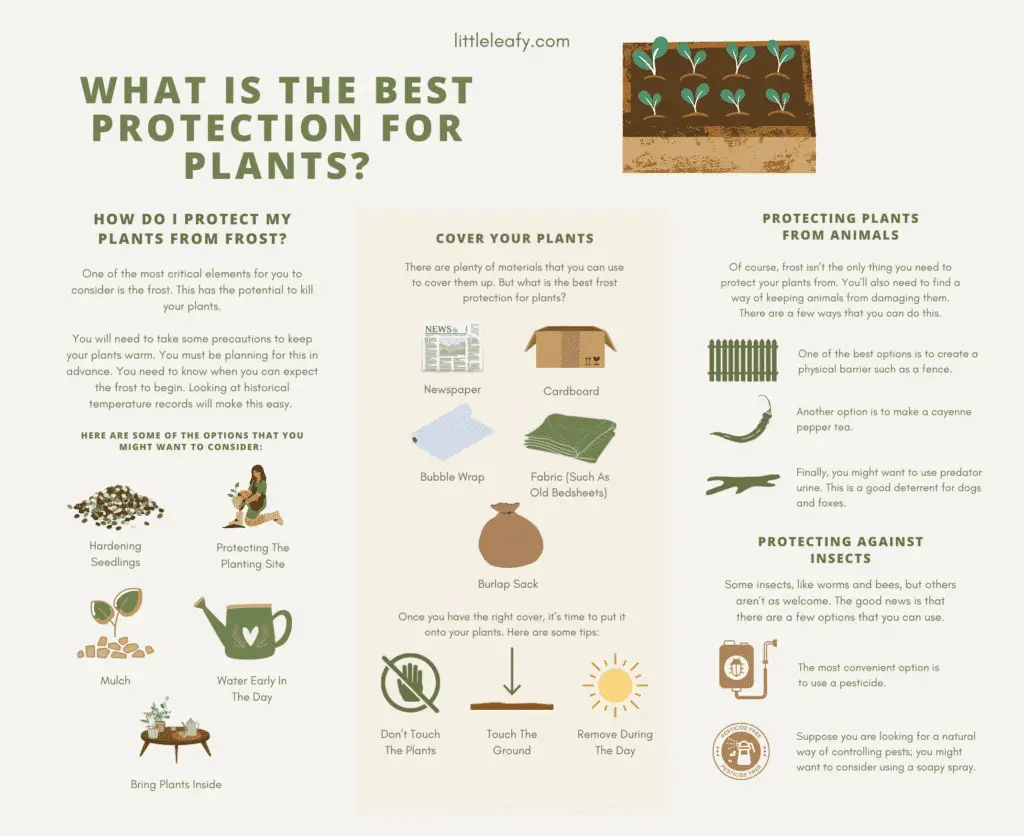Reading Time: 5 minutes 🍃
If you have plants, you want to ensure that they will thrive for a long time. This means protecting them from harsh environmental conditions. But what is the best way to do this?
There are a few ways that you can protect your plants from frost. For example, you can harden the seedlings or apply mulch to the soil. It can be best to use a cover, preferably made from a breathable fabric rather than a hard plastic.
There are plenty of ways that you can protect your plants from damage. Keep reading to learn more about some of the things you need to know.
How Do I Protect My Plants From Frost?
One of the most critical elements for you to consider is the frost. This has the potential to kill your plants. In this case, the water will freeze inside the plants, causing ice crystals. This will result in them becoming limp. Younger saplings will be more seriously affected than older, more mature plants.
You will need to take some precautions to keep your plants warm. There are a few ways that you can do this. The correct course of action will often depend on how cold it will get in your part of the world.
You must be planning for this in advance. You need to know when you can expect the frost to begin. Looking at historical temperature records will make this easy. You don’t want to be taken by surprise, not having enough time to prepare your plants for frost.
When the colder weather does start to roll in, you’ll need to make sure that you have the right amount of protection. Here are some of the options that you might want to consider :
:
- Hardening seedlings. If you have seedlings, you’ll need to make sure that you are preparing them for the winter conditions. The best way to do this is through the hardening-off process
 . This means that you will need to gradually start to move the pot outside, getting them used to the cold. This is a slow process, often taking place over a week.
. This means that you will need to gradually start to move the pot outside, getting them used to the cold. This is a slow process, often taking place over a week. - Protecting the planting site. It’s important to think about the weather conditions and the future when deciding where you are going to plant your seedlings. If they are sensitive to the cold, it’s good to put them into a more protected area. Aim for something that will protect them against the wind and any snowfall. This can mean planting them near a wall or close to some existing trees or shrubs.
- Mulch. When you know that a frost is coming in, it’s good to add a little mulch to the soil. This will provide a thick layer of soil, keeping the heat in the ground. How thick the layer of mulch will need to be will depend on the type of plant. Generally, it’s a good idea to aim for around two to four inches deep.
- Water early in the day. If a plant is dehydrated, it will be more negatively affected by the frost. If the soil is a little damp, it will be better able to hold heat, stopping the ground from freezing. Just make sure that you are watering early in the day. This ensures that the plants will have plenty of time to absorb the water.
- Bring plants inside. If you have sensitive pot plants, it might be a good idea to bring them inside the house. Alternatively, you can build a greenhouse.
One of your best options is to cover the plants. You will be able to protect them against frost and ice. It’s also an excellent way to warm the soil. There are plenty of materials that you can use to cover them up. But what is the best frost protection for plants?
First, you can try newspaper or cardboard. While these are low-cost, it can be challenging to get them to stay in place. You don’t want them to blow away. If you are looking for a cheap way of covering plants, you might want to consider bubble wrap.
It’s usually best to use some fabric. This will allow the soil to breathe while keeping plants warm. You will be able to use old bedsheets. You can also use a burlap sack. If you prefer, you will be able to purchase covers from your local hardware store. Anything that will cover the base of the plant, protecting it from frost, will work.
Once you have the right cover, it’s time to put it onto your plants. Here are some tips you’ll need to keep in mind:
you’ll need to keep in mind:
- Don’t touch the plants. If the cover is touching the plants, it can be doing more harm than good. It will be holding the moisture against the plants, which can cause them to freeze. It’s best to put some stakes around the plants, then drape the cover over them.
- Touch the ground. The cover should be able to touch the ground. This will ensure that you are keeping the heat close to the soil.
- Remove during the day. Whether you need to do this will depend on how thick the cover is and how breathable it is. You don’t want the ground to be getting too hot, as this can also damage your plants.
Protecting Plants From Animals
Of course, frost isn’t the only thing you need to protect your plants from. You’ll also need to find a way of keeping animals from damaging them. There are a few ways that you can do this.
One of the best options is to create a physical barrier. Putting up a fence around your garden will be able to stop unwanted animals from breaking in. How high you will need to make the fence depends on the type of animals you have in your area. If you have rabbits, your fence will need to be around three feet high. If you are concerned about dogs, it might be better to use a six-foot-high fence.
Another option is to make a cayenne pepper tea. This is a hot mixture, which burns the tongue of animals when they taste it. Spraying this around the garden will hurt predators. But it shouldn’t have any impact on the growth of your plants. Here are the steps you will need to follow to prepare this tea .
.
Finally, you might want to use predator urine. This is a good deterrent for dogs and foxes. It makes them think that there is a larger predator in your yard. This will often be enough to convince them to keep their distance. You can combine it with one of these other measures to get something even more effective.
Protecting Against Insects
Some insects, like worms and bees, but others aren’t as welcome. The good news is that there are a few options that you can use. The most convenient option is to use a pesticide. This can be found at a hardware store. However, these chemicals can do some harm to the environment.
Suppose you are looking for a natural way of controlling pests; you might want to consider using a soapy spray. This is very easy to operate. You need to mix a generous squirt of soap with water in a spray bottle. Apply this over your garden.
Final Thoughts

There are plenty of ways that you can protect your plants from harm. One of the biggest problems will be a harsh winter frost. There are many ways to keep plants warm, but a breathable fabric cover will be best. There are natural ways to protect your plants from insects and animals.

